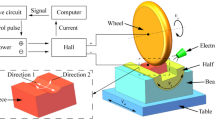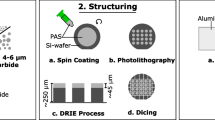Abstract
A new finishing mode has been utilized as an effective finishing tool design with an electrode and a nonconductive grindstone to execute grinding and electrochemical smoothing synchronously. This mode can be used for various end-turning operations. Through simple equipment attachment, grinding and electrochemical smoothing can follow the cutting process on the same machine. Among the factors affecting electrochemical smoothing, grinding performance combined with electrochemical smoothing, is primarily discussed. In the experiment, different types of electrodes are used with continuous and pulsed direct current. The control factors include die material, chemical composition, and concentration of the electrolyte. The experimental parameters are finish tool and workpiece rotational speed, flow rate of electrolytes, gap width between electrode and workpiece, electrical current density and pulsed period, and finishing tool geometry. High workpiece and electrode rotational speed produces a better finish. A thin electrode is associated with higher current density and provides larger discharge space for a better finish. Pulsed direct current can promote the effect of electrochemical finishing. Decreasing the height of the finish tool to a partial-form tool is associated with less restricted electrolyte flow and more discharge space, which creates better finishes than the full-form tools. The grindstone, with an adequately convex shape, also appeared to have an adequate initial gap width between the electrode and workpiece, which matches enough current density and obtains a better finish. The most effective geometric design for the finishing tool and the advantage of the low-cost equipment in electrochemical smoothing, following end-turning, is investigated in this study.
Similar content being viewed by others
References
Philip K, Lewis L, Sais J (1999) Study of intelligent prediction control of surface roughness in grinding. Int J Mach Tools Manuf 39:1451–1470
Cheng M, Li X, Sun F, Xue B (2001) Studies on grinding characteristics of directionally solidified nickel-based superalloy. J Mater Process Technol 116:165–172
Amstead BH, Ostwald PF, Begeman ML (1977) Manufacturing processes. Wiley, New York, p 614
Howes ID, Neailley K, Harrison AJ (1987) Fluid film boiling in shallow cut grinding. Ann CIRP 36(1):223–226
Tian X, Lin B (2004) Development of high-speed and ultra-high speed grinding technology and Its key points. Precise Manuf Automat 158:23–24
Brinksmeier E, Brockhoff T (1996) Utilization of grinding heat as a new heat treatment process. Ann CIRP 4(1):283–286
Liu J, Wang G (2003) Current state and development trend in research on grinding hardening technology. Modern Manuf Eng 11:81–83
Jenkins HE, Kurfess TR, Dorf RC (1996) Design of a robust controller for a grinding system. IEEE T Contr Syst T 4:40–49
Jackson MJ, Robinson GM, Dahotre NB, Khangar A, Moss R (2003) Laser dressing of vitrified aluminium oxide grinding wheels. Br Ceram Trans 102(6):37–245
Wilson JF (1971) Practice and theory of electrochemical machining. Wiley, New York, pp 79–161
Phillips RE (1986) What is electrochemical grinding and how does it work? Carbide Tool J 18(6):12–14
Mileham AR, Harrey SJ, Stout KJ (1986) The characterization of electrochemically machined surfaces. Wear 109:207–214
McGeough JA (1974) Principles of electrochemical machining. Chapman and Hall, London, pp 1–10
Bannard J (1977) Effect of flow on the dissolution efficiency of mild steel during ECM. J Appl Electrochem 7:267–270
Shen WM (1995) The study of polishing of electric discharge–machined mold with ECM. MSc Thesis, National Yunlin Institute of Technology, Taiwan
Datta M, Landolt D (1981) Electrochemical machining under pulsed current conditions. Electrochim Acta 26(7):899–907
Rajurkar KR (1995) Modeling and monitoring interelectrode gap in pulse electrochemical machining. Ann CIRP 44:177–180
Cagnon L, Kirchner V, Kock M, Schuster R, Ertl G, Gmelin WT, Kuck H (2003) Electrochemical micromachining of stainless steel by ultra short voltage pulses. Z Phys Chem 217:299–313
Institute of Advanced Manufacturing Sciences (1980) Machining data handbook, 3rd edn. Institute of Advanced Manufacturing Sciences, Inc., Cincinnati, OH, vol 2, sect 18, p 11
Azcue JM (1995) Comparison of different cleaning procedures of root material for analysis of trace elements. Intern J Environ Anal Chem 62:137–145
Kamada H, Tamiya K (1982) A study on electrolytic-abrasive mirror finishing. Bull Jpn Soc Precis Eng 16(2):109–110
Yasunaga N (1997) Recent advances in ultraprecision surface finishing technologies in Japan. In: Proceedings of the international symposium on advances in abrasive technology, Sydney, pp 18–27
Popilov LJA (1982) Electrochemical and electro-physical machining. Masinostrojenije, Moskow (in Russian)
Jones T (2004) Electropolishing of precious metals. Metal Finish 102(7–8):45–49
Jain VK, Yogindra PG, Murugan S (1987) Prediction of anode profile in ECBD and ECD operations. Int J Mach Tools Manuf 27(1):1135–1349
Hocheng H, Pa PS (2002) Application of turning tool as electrode in electropolishing. J Mater Process Technol 120:6–12
Hocheng H, Pa PS (2003) Electropolishing of cylindrical workpiece of tool materials using disc-form electrodes. J Mater Process Technol 142(1):203–212
Pa PS (2006) Design of completely inserted and feeding electrode for female screw in electrochemical finishing. Key Eng Mater 329:231–236
Pa PS (2007) Design of effective plate-shape electrode in ultrasonic electrochemical finishing. Int J Adv Manuf Technol 34:70–78
Kim BH, Ryu SH, Choi DK, Chu CN (2005) Micro electrochemical milling. J Micromech Microeng 15:124–129
Hocheng H, Pa PS (2006) Using borer-shape electrode in electrochemical smoothing of holes. Mater Sci Forum 505–507:793–798
Author information
Authors and Affiliations
Corresponding author
Rights and permissions
About this article
Cite this article
Pa, P.S. Synchronous finishing processes using a combination of grinding and electrochemical smoothing on end-turning surfaces. Int J Adv Manuf Technol 40, 277–285 (2009). https://doi.org/10.1007/s00170-007-1329-9
Received:
Accepted:
Published:
Issue Date:
DOI: https://doi.org/10.1007/s00170-007-1329-9




